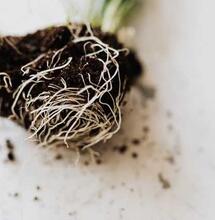What are the differences between soil and coco?

There are many ways to grow cannabis plants. The most basic involves using soil and watering them manually, while more complex options involve using inert growing media and hydroponic nutrients. Here is everything you need to know about growing cannabis using soil or coco
Growing in Soil
Soil is essentially compost broken down and processed to become a nutrient-rich, slow-release, and easy-to-use growing medium. Many nutrient brands in the cannabis industry produce premium soils designed to nourish plants from seed to harvest. Good quality soil is able to retain water while surrounding the roots with air pockets. The consistency should be airy and the texture spongy when squeezed. The aroma of the soil is also an indicator of its freshness, fertility, and microbial richness.
Wicking Ability
Cheap soils that can be purchased at your local hardware or garden centre will not have the best overall qualities compared to a well-established brand. Soil mixed with perlite will likely wick water slowly to the roots. Poorly aerated soils become too heavy when saturated with water and can take longer to dry out.
Drainage Quality
Soil has the ability to hold a lot of water for long periods of time. It is important to make sure that the soil you use is well-draining, meaning that once you add water, it drains out of the base of the pots within 60-90 seconds of hand watering. Soil does not need a lot of water to begin with. Cheap soils will quickly become waterlogged and cause the roots to oversaturate.
You can’t go wrong with soil. For beginner growers, the soil is great. Soil is a convenient, forgiving, and user-friendly organic growing medium
Advantages
• It is hard to overfeed your plants when growing in soil and watering. • The final taste in comparison to cannabis grown with chemical nutrients will be better.
• Potting soil has a 3-day buffer period once you have fed a liquid feed.
• There are a wide range of premium potting soils available to purchase online.
• Self-mixed potting soils are easy to prepare and allow the grower to customize them.
• Soil can be easily mixed with coco and perlite to create additional air pockets.
• Well-maintained soil can be reused after the plants have been harvested.
Disadvantages
• Cheap potting soils lack essential nutrients and trace elements that plants need.
• Yield will always be lower in soil than in hydro.
• Soils that are not aerated adequately can lead to root rot and slow growth.
Growing in Coco
Coco is a very soft and airy growing medium made from treated hairs from coconut husks. What makes coco so different from soil is the fact that it contains no nutrients (in tiny amounts). This allows growers to feed their plants with hydroponic nutrients and know exactly how much fertilizer the plants are receiving.
As a result, plants grown in coco are well known for growing large and producing much larger yields than those grown in soil. It would probably be fair to say that coco is on par with hydroponic systems such as DWC in terms of yields.
Many growers believe that coco strikes the perfect balance between aeration, and moisture-wicking ability and allows for an abundance of roots.
Wicking Capacity
Coco is able to hold up to 10 times its own weight, meaning you don’t need to give a large volume of water at each feeding. Coco is also full of tiny fibres and air pockets, making it ideal for hydroponics and reducing the risk of over-watering.
Skill Level Required
Drainage
Compared to soil, coco requires more maintenance such as checking the pH of the water and nutrient solution and adjusting the EC based on fertilizer concentration, water temperature, and watering frequency. It is however a very simple and convenient growing medium that can be easily customised by the adding of organic elements if needed.
Advantages
• Coco is very airy, and lightweight, and produces high-yielding cannabis plants
• It is possible to grow in small pots using coco and grow large plants.
• Coco can be reused once treated with enzymes after harvest.
• Perlite added at a rate of 30-50% is a popular choice among growers.
Disadvantages
• Not ideal for a beginner grower who is unfamiliar with fertilizers.
• Coco may need to be buffered and treated before you use it.
• Some brands offer coconut bricks, often rich in salts.
More From Soft Secrets:



.png)




